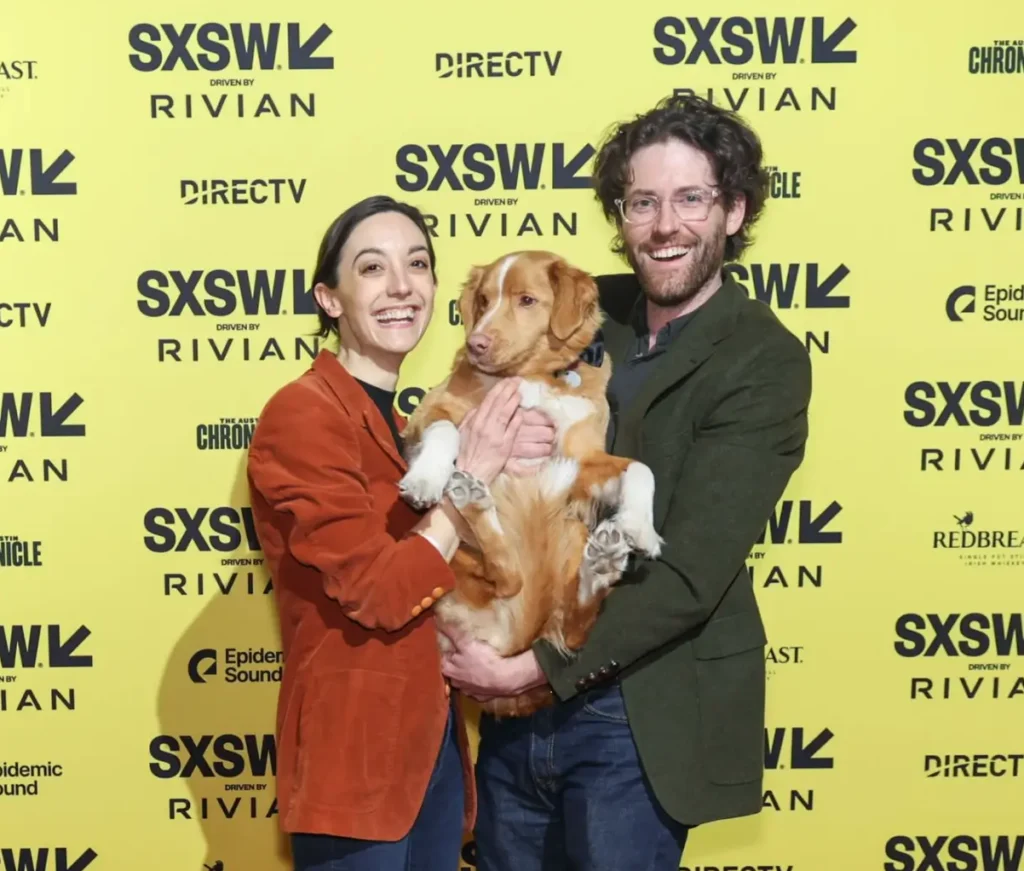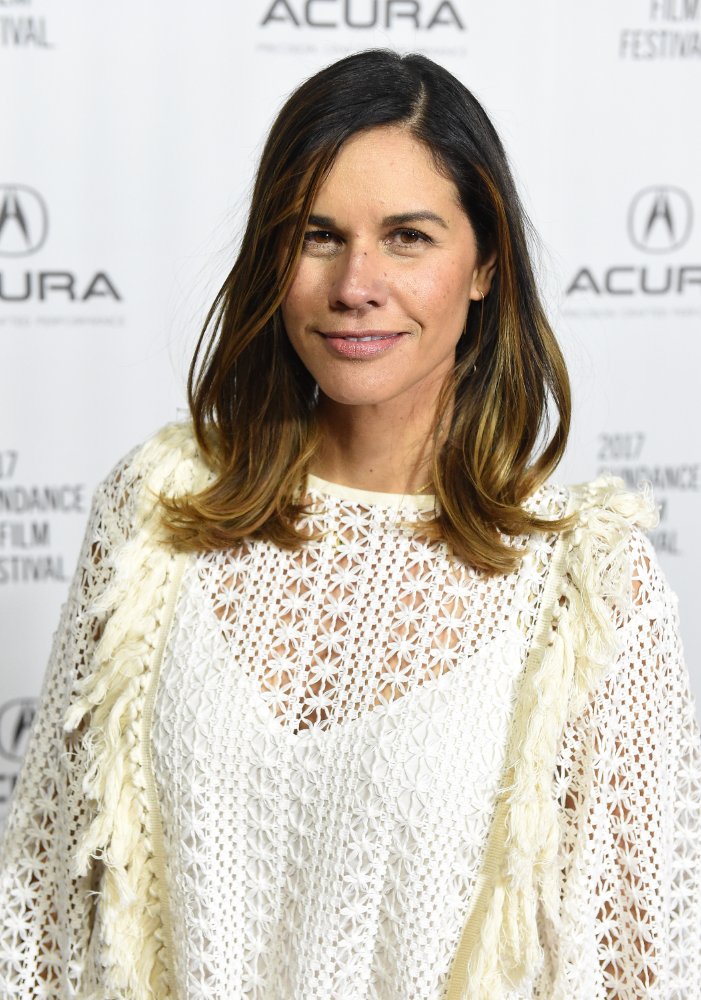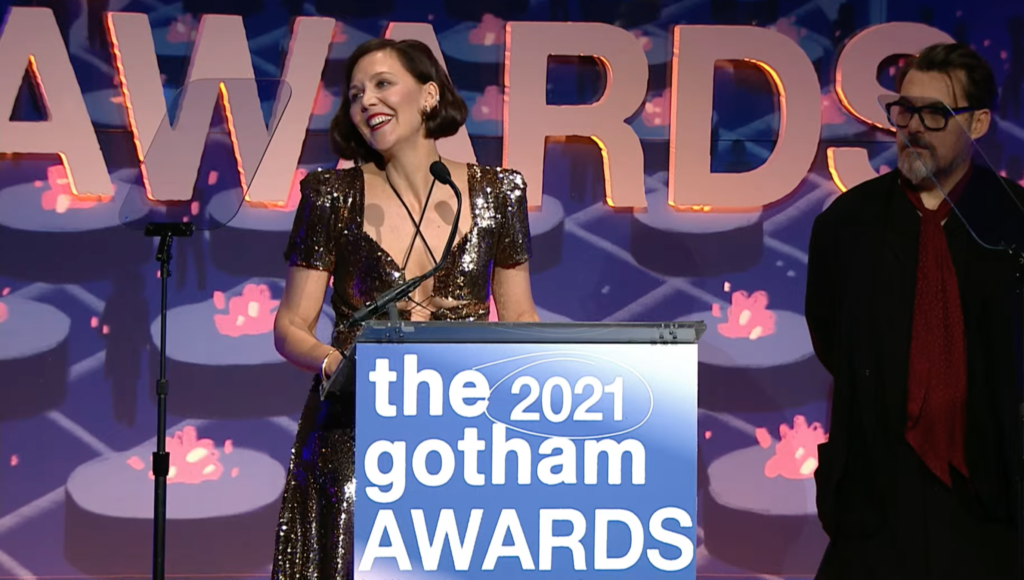With apologies to Cujo, historically, cats have ruled in the horror genre. Movie cats leap out of the shadows for a jump scare, prowl as an omen of cursed things to come, or curl up to their witchy companion as spells are cast. Dogs, however, are more often the stars of cute family fare, going on adventures, getting into mischief, and teaching their humans valuable life lessons. The new film GOOD BOY flips the switch by bringing a pooch to the forefront of horror as perhaps cinema’s first Canine Scream King.
What began initially as a proof-of-concept short soon blossomed to full-length, and the team behind the feature debut didn’t have to look too far to find their star. Director/co-writer/producer/cinematographer BEN LEONBERG and his producer and wife KARI FISCHER cast their own retriever, Indy, as a dog who accompanies his person to a remote house in the woods, where evil spirits — that only Indy seems to sense — are lurking. Human actor (and horror veteran) Larry Fessenden co-stars in the film, which premiered at the 2025 SXSW Film Festival and won the Howl of Fame Award for Best Canine Performance.
Independent Film Company and Shudder will release Good Boy in theaters on October 3. Leonberg and Fischer were kind enough to talk with us — and brought Indy along as well — about their process making this truly unique thriller told from an animal’s POV.
__
COLIN McCORMACK: First things first, how and when did this leading man first come into your life?
BEN LEONBERG: We got Indy as a puppy, definitely not thinking he would be in movies. We got him in 2017, so he’s going to be eight years old. If only we could all age like Indy. He never needed hair and makeup over the three years of production, and doesn’t seem to have aged a wink. We got him just to be our friend and companion, and he certainly is that. But fortunately, he’s also the kind of dog that is very smart and active and loves to have a job, which were important alchemical elements in actually pulling this off.
CM: Ben, you’ve had a film career, making shorts, commercials, and VR projects. But Kari, this is your first credit as a producer. So what was that conversation like that got you to agree to jump into this indie filmmaking world for the first time?
KARI FISCHER: Yeah, even when Ben was in grad school, I made a point of not working on his films. Then the short had done really well and enabled Ben to even think about making the movie. Part of it was a fair bit of prize money that enabled him to buy some of the equipment that was needed. Then we just had a conversation about how to make this and how we were going to get him his first feature. And this was all swirling around the pandemic, too, so that was a big part of it as well. It was like, “Well, hey, we’re here” [laughs]. “Let’s do this.”
BL: So much of this was a necessity of, What does it take to actually get a performance out of a dog? Now that we’ve determined we like what our dog can do, and people are responding to him, how do we make that happen? And then we reorganized our lives to make that happen. We lived in the house you see in the film. So it’s Indy’s real house, which is why he acts like he lives there because he does. And we’re both in his life, so we’re just along on his ride. Or he’s on ours.
CM: Were you writing the script aiming towards makeability and putting things into the film that you knew you’d have at your disposal?
BL: Not originally, no. I started writing the film in 2012, just based on the concept of having watched Poltergeist for the millionth time. There’s a golden retriever that opens that movie that is clearly onto the fact that the house is haunted before any of the people. And I thought, Man, someone should tell a haunted house story entirely from a dog’s perspective. For years, my co-writer [Alex Cannon] and I were trying to figure out how that actually would work, especially with a more realistic canine protagonist. The dog doesn’t have superpowers, he can’t talk, he’s just a normal dog. So we spent a long time trying to crack, Could this work? How would you build tension the same way most horror and ghost stories do with actors? You tell an actor, “Walk into a room, pretend to hear a sound from the corner. We’re going to have your point of view, and then a shot of your reaction as you see a shadow move.” You can’t tell a dog to do those things and explain it with any level of sophistication. You just have to make the movie around them.
We started doing tests when Indy was about a year and a half old, not with the intention that he would be our lead actor. In some cases, we recreated scenes from The Shining, but instead of Danny, we now have a dog. That taught us how to both tell a story using visuals and no dialogue, and also informed us how you could work with a dog who’s already in your life. And people responded to him so strongly, it kind of forced our hand.
CM: Did the format of the screenplay look like a regular script, or did you have to adjust it since so much of what you’d be capturing wouldn’t be dictated [to actors]?
BL: We found a way to write pretty much everything. I guess we always thought of the script as more like a script for an action movie, just because the dialogue is not the most important thing in almost any scene. The dialogue is more incidental, which is not to take anything away from the actors who bring the performances to life and make it feel real, and bring that connection. But the narrative is unfolding through perspective. So we were frequently writing, “Indy’s point of view sees this.” “Indy reacts this way.” Maybe that’s a little bit of a break [from the norm]. Most scripts wouldn’t have that level of detail. But because that’s the main way we are conveying information to the audience, noting the point of view and the perspective was a constant, important thing to have in every scene in the script.
CM: How do you even go about scheduling a film shoot like this? Are you basing shoot days on script pages like a regular production would?
KF: No, not at all. Not until we actually got to the point of having actors. Then it looked far more traditional.
BL: We filmed for over 400 days. We don’t know the exact number. Over 400 days over a three-year window with just me, Kari, and Indy, filming with him in this house and slowly chipping away at it. Part of the reason it’s so hard to schedule something like this is that Indy is just too big of an X factor. Our expectation is, Here’s what we think he’s going to do in the shot that I’ve spent all day setting up. And now that the sun has gone down and Kari’s off to work on the other job, and we have the ability to actually film, Indy either can’t do it or does something else. And we have to adjust.
The way I described it to people who have some awareness of how a production can function is that it was like one of those multi-year portrait documentaries that follow a person over the course of years. Not to say this was a documentary. Indy is being himself, but he’s also responding to stimuli. We’re providing him with something that looks like a performance when edited in concert with everything else. Once we had all that footage, it was like, “Okay, now we need actors.” That’s when it became more like a real movie. We actually had the actors come to set and rerecord the lines in the physical spaces. It’s just a vocal performance, but our sound team was really able to use those lines in the locations to make it sound like it’s not ADR.
KF: And there was the shoot with Larry Fessenden, which was him on camera. And that was functioning like an actual film set.
BL: We had a very small number of real shoot days, but it was a delight to have them because it was after three years of making a movie with a dog who does not know he’s in a movie. To say to Larry, “You know how this works,” and he does, and he does what’s in the script, and is an absolute pro, it was a delight.
KF: And he understands the premise that we’re making a movie.
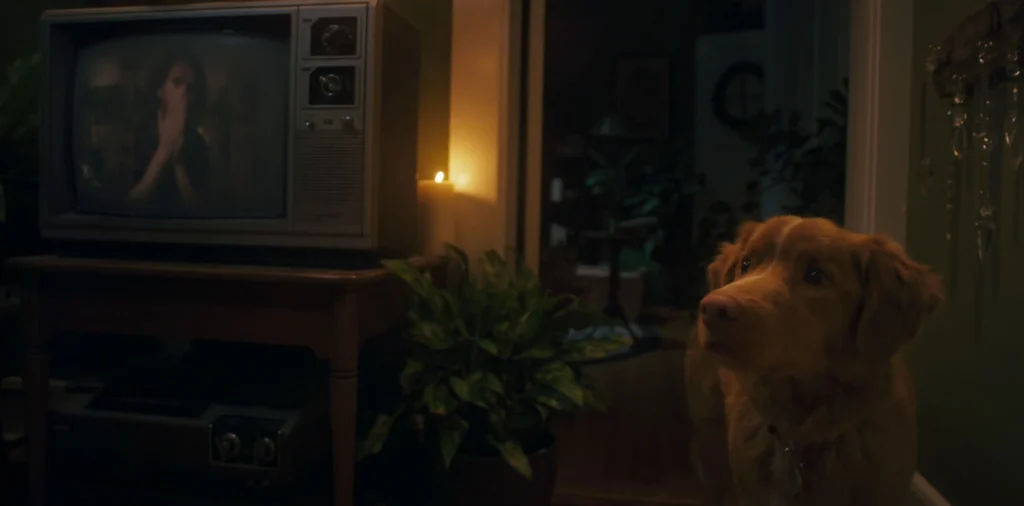
CM: Kari, producing such a unique type of production, do you feel like you could jump into any type of film now? Because who else has a 400-day shoot under their belt as a first film?
KF: So much credit to the people who do this full-time. I learned a ton. And I learned from a lot of really great people, Ben and his friends and former professors. He gave me the book Producer to Producer, which has been invaluable.
BL: We got to have calls with Maureen Ryan, the author, which was great. We did have good help, but she’s being modest. Kari’s very smart; she’s a scientist. It wasn’t super hard for her to figure out filmmaking, which is not to take anything away from us filmmakers, but she’s pretty clever [laughs].
CM: When you were looking for visual inspirations for the film, maybe some horror films or thrillers might be the obvious touch points. But since most films that have a dog’s POV are more family-friendly, were there some unexpected inspirations?
BL: Oh yeah, I know a lot about dog acting. The dog actor named Jed played White Fang most famously in the Ethan Hawke White Fang film. He’s also the dog in John Carpenter’s The Thing, and John Carpenter talks on the director’s commentary about working with this dog that had this incredible thousand-yard stare that, as a filmmaker who uses subjectivity and point of view so well, he was able to make complete hay out of. So, learning about how he worked with Jed was really inspiring and informative. That was the gold standard we were trying to hit. And Air Bud is genuinely amazing. It’s exactly what you say, a family-friendly movie. It’s more of a dog acting like a dog, not the thoughtful, gear-turning subjectivity we were trying to bring. But there are sequences in Air Bud that are action scene stunts where they’re using multiple dogs, but it all appears as one dog, and it’s one continuous shot that is just a marvel. So yeah, I’ve watched a lot of dog-specific filmmaking [laughs].
CM: When people started seeing footage of Indy, like you said, they connected to him. But was there something about his general demeanor or his ability to be trained that gave you faith that he would pull off what you needed from him?
BL: One of the things is he’s a naturally very serious and smart dog. And we noticed, well before we started trying to make a movie with him, that he has a very intense stare. For people who have dogs, what I’m talking about is, you know the eternity that elapses between you filling a dog’s bowl and you putting it on the ground for them to eat it? That stare. He’ll throw that at us all the time. And we were thinking, That is a useful tool. He’s so serious and has these very thoughtful-looking eyes. Objective shots of that, combined with a subjective point of view, we could make a whole film just with that.
KF: His eyes are also unusual. A lot of the dogs that we grew up with had much darker pigment in their eyes. But he has the iris that you can actually see, and the whites of his eyes as well. So that really lends itself to you picking up on — or thinking that you’re picking up on — what he’s thinking.
BL: It’s really subtle, but that’s such a good point. Every dog has an iris and a pupil, but if a dog has one large, almost doll-like eye, it’s hard to see. And since he has both the white and the iris, he looks a little bit more human, just by virtue of the pigment of his eye color.
CM: As you were working with Indy and learning the tricks of filming with a dog you knew so well, how did that come into play when you had another dog actor, the dog who plays Bandit, come on to set?
KF: That dog is Max, who belongs to Ben’s parents. And Max is much more of your typical golden retriever. So, as Ben likes to say, he is much less professional. With Indy, you could kind of place him in a shot or move him around a little bit, and he’d be really great about standing still. But as soon as you touch Max, he’s like, Okay, belly rub!
BL: If you brush against Max, he falls to the ground and shows his belly because he wants a belly rub. It is a hard thing for filmmaking.
KF: It really made us appreciate Indy so much because that was so valuable.
BL: Max still does an amazing job, and he was certainly available, and he knows Indy. It was an easy thing to slot in, but it was a challenge after spending years getting used to working with Indy to slot in Max for his freshman effort.
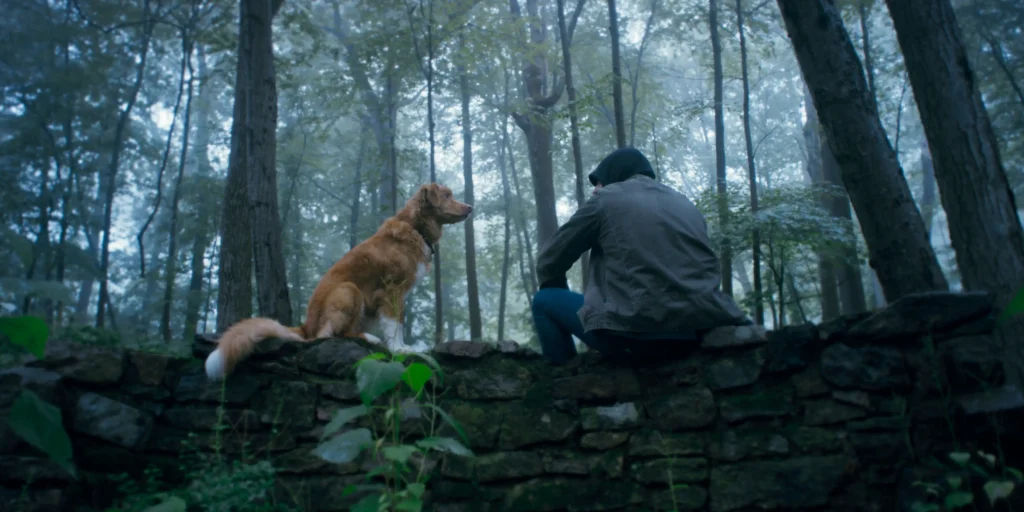
CM: When you’re filming outside in the woods, how did you eliminate or curb potential distractions for the dogs?
BL: Part of the advantage of making a film for as long as we did is that we had the runway to film during very specific conditions that were the best for Indy. Fortunately, he’s got a thick double coat, so it’s almost never too cold for Indy. We’re the ones who have to put up with that. The summer isn’t a great time to film outside anyway because he’d be panting, and that wouldn’t look right for the performance. Cooler days and nights, where there aren’t rabbits scampering around the yard and birds flitting around, make it easier for him to focus.
KF: Treats. Treats were key, for sure.
CM: You talked about bringing in another dog actor, but for the human actors you brought in, what was that casting experience like?
BL: Really unique. Larry Fessenden, who plays Grandpa, is the only person we see on the screen who is both the vocal and physical performer. All of the other human bodies you see on camera are Kari and me. Actors are replacing our voices, in the same way James Earl Jones plays Darth Vader, to give a very broad example. And to be very clear, we are not actors. What we were doing on set was talking to Indy while cameras were rolling, so the production audio is just commands and encouragement or stimuli we’re giving for the benefit of Indy. We both needed to find actors who, of course, are great actors, but in addition to that, they needed to plausibly sound correct when coming out of whatever costume and physicality we have. It was a unique challenge and kind of a hard alchemy to thread. It was strange.
KF: It took a couple of tries to find someone who made sense coming out of Ben’s body. As Ben said, it was an alchemy to try and figure that out, but it was amazing because then once we did find Shane [Jensen], you didn’t even think about it. It felt so natural and inherent and it was perfect.
BL: I have to give it to Shane, who plays Todd, who has the most lines, and Arielle Friedman, who plays Vera. They did just such incredible work. There’s one scene where there’s so much physicality that they had to bring into the vocal performances that are not normally a consideration. They had to say a line in a way that’s a good line, but also I’m sitting up — not because that’s how I’m supposed to say the line, but because Indy did something and I’m reacting to it. It’s not an art, it’s a science. I have so much respect for what they did, and it’s an incredibly difficult job.
KF: We brought them on set to do it, too. That was really important to our sound designer to get the correct ambisonics as well, so it sounded like it was in the space. We had Shane walking up the stairs to be able to get that right delivery.
BL: All that said, it was still a really fun thing to challenge you. We needed people who saw it the same way. That was a big part of the casting as well.
KF: And again, just working with people who understand film [laughs].
BL: Yes, it was a joy. As complicated as that was, I can tell them, “Hey, this can be complicated.” If they agree, then we move forward.
CM: Any performance — human, or especially, animal — is formed so much in the edit. What did you learn during post-production to best frame a dog’s reactions or movements to read the way that you want them to once everything is cut together?
BL: This goes into the weeds of filmmaking, but the Kuleshov effect is where we see an expression of an actor with a blank face, and then, because of the point-of-view shot, we can feel what the actor is feeling. In the edit, that was one of our most important tools. There’s an interesting lesson that I’m still learning from working with Indy about how much audiences bring the performance to films, even with human actors. I think some of the best and most beloved actors don’t necessarily “do a lot.” I’m putting air quotes around that. Their faces and expressions allow audiences to see themselves in the character or project themselves onto the character.
For Indy, practically, what that means is that with a neutral expression from him, the filmmaking is telling the audience how to feel. In reality, he’s just looking at me standing behind the camera, like, What is Dad doing? With the filmmaking of the ominous corner and the music, the audience feels, Oh man, that dog is afraid. He’s not. The filmmaking is making you, the audience, afraid. You’re putting that onto him. That might be a little convoluted, but I think there’s a really interesting filmmaking and performance lesson there.
CM: What’s next for both of you and for Indy?
KF: I’m going back to having just the one job. My day job is great. I work for the Lupus Research Alliance, so I’m very happy doing that.
BL: My co-writer and I have several stories and films planned. With Good Boy, you see that the perspective is part of the storytelling, in a very literal sense. The camera is just a few inches off the ground, and we’re using that limited perspective as a way to unfold the narrative. Using point-of-view that way is something I’m going to continue to play with. That’s certainly part of the next film. It doesn’t have a dog. I’m very excited to work with a cast of human actors who all agree on the reality of the premise that we’re making a movie.
For Indy, he’ll keep having a job. That job is to be our friend and make us happy.
KF: And the other way around.
BL: Yes. I don’t know if Indy will be pulled into more movies. I think he has a well-deserved retirement, if he wants it.
__
Thanks to Ben and Kari (and Indy!) for talking to us about GOOD BOY. Learn more about the film at goodboy.movie.
This interview has been edited for clarity.
If you’re an independent filmmaker or know of an independent film-related topic we should write about, email blogadmin@sagindie.org for consideration.

